Like much else in Jordan, the variety and quality of sightseeing opportunities will take visitors by surprise if they haven't done their homework. There is far more to see than just desert landscapes, although these are just as astoundingly beautiful as any others in the world. Jordan gives travellers a great way to see the Middle East in a safe environment, and everything visitors could want out of a desert adventure can be found here. Jordan is on friendly terms with its neighbours, making it the safest destination to travel to in the Middle East, all while serving up fantastic sights such as the ancient and wonderful city of Petra.Beyond Petra, there are many other fascinating desert cities, castles and fortresses to be explored, many of which can easily be accessed from the capital of Amman or from the lively city of Aqaba. Visitors can opt to take these excursions by local taxi, hired car, 4x4 or do it in style, atop a camel, as native Jordanians have done for centuries. Not merely a land of desert and camels, there are great opportunities for visitors to get their feet wet in either the Dead Sea or the Red Sea. While the Red Sea (situated at the very southernmost tip of Jordan) offers up a fantastic chance to swim and scuba in crystal clear waters, harbouring some of the most spectacular coral reefs in the world, the Dead Sea experience is something totally different. The lowest point on earth, the Dead Sea allows swimmers to float weightlessly in its extremely salty waters.

Originally spread over seven hills, or jabals, the capital of the Hashemite kingdom now sprawls over 19 hills and is home to over a million people, almost half of Jordan's population. Known as the White City, the hills are covered in a jumble of light-coloured stone houses, consistently box-like in shape with flat roofs characteristic of a typical desert city.Faded minarets, pavement markets, Arabian sweet shops, and the crumbling remains of ancient civilisations contrast wonderfully with the contemporary edifices, fashionable boutiques and international restaurants. This blend of the old and the new combines in the noisy and chaotic downtown area where the city's extraordinarily friendly residents go about their business.At the heart of downtown is the Ottoman-style King Hussein Mosque, around which the buzz and bustle is at its most interesting. Even busier at prayer times, the surrounding streets are filled with the essence of Arabia, exotic smells and rows of glittering treasures in the souq (market) amid the noise of frenetic haggling.Just as overwhelming is Amman's sense of history, dating back 5,500 years to its position as the ancient capital of the Ammonites, Rabbath-Ammon of the Old Testament, and later as Philadelphia, the Roman city that became part of the Decapolis. Overlooking the city from atop Jabal al-Qala'a is the Citadel, the site of the ancient Rabbath-Ammon, and at its foot lies the impressive Roman amphitheatre that is the most remarkable remnant of ancient Philadelphia.Amman is one of the oldest, continuously inhabited cities in the world, and today functions as a thriving commercial and administrative centre with modern facilities, historical attractions and a longstanding tradition of hospitality. It is an excellent base from which to explore the surrounds, even the rest of the country as its no more than five hours drive from anywhere, and is surprisingly agreeable for a capital city.
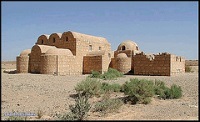
Stretching to the east of Amman towards Saudi Arabia and Iraq is the vast desert plain where a cluster of historic ruins such as castles, forts, baths, and palaces have been preserved. They are collectively known as the Desert Castles. Their purpose is largely unknown, but most are thought to have been built as recreational retreats by the Umayyad caliphs during the early Islamic Period (7th to 8th centuries AD). Qasr Mushatta is the biggest and most elaborate of the castles, a fine example of Umayyad architecture despite never being completed. The best preserved and most enchanting is the luxurious bathhouse of Qusayr Amra, with its domed ceiling, colourful interior frescoes, and mosaics. It's also a UNESCO World Heritage Site. Other desert castles include the black rock fortress at Azraq, which was the desert headquarters of Lawrence of Arabia during the Great Arab Revolt in 1917, the mysterious Qasr al-Kharrana, Qasr al-Hallabat's crumbling remains, and the well-maintained complex at Qastal.
Transport : Most of the castles can be visited on a day trip from Amman via Azraq by using a variety of public buses and minibuses combined with hitching or walking, although it is easier and less time consuming to hire a car or a taxi for the day; hotels can arrange drivers who know the way and speak English
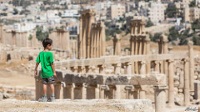
Situated about 31 miles (50km) north of Amman is one of the top attractions in Jordan: the ancient city of Jerash, considered to be one of the best-preserved Roman sites in the world. Its exceptional preservation is due to it being buried in sand for centuries and the magnificent baths, theatres, temples, arches, columns ,and stone chariot-rutted streets have long attracted scholars and tourists from across the world to admire the most complete city in the Roman Decapolis. Excavations dating to the Neolithic Age have indicated that Jerash was continuously occupied for more than 6,500 years. Today visitors can marvel as the ancient amphitheatre comes to life at the annual Jerash Festival of Culture and Arts, where artists from around the globe sing, dance, act, and play music on stage in a celebration of Jordanian and international culture.
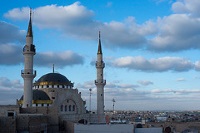
Madaba is most famous for its spectacular Byzantine and Umayyad mosaics from the 5th to 7th centuries which are scattered throughout the town's homes and churches. Located just 19 miles (30km) south of Amman, Madaba is also home to the famous 6th-century mosaic map of the Holy Land, in which Jerusalem and its surrounding regions are depicted. One of the town's most beautiful mosaics covers the floor of the Byzantine Church of the Apostles, and the Archaeological Park features an impressive collection of mosaic collages, where a series of ramps has been built over excavated mosaics to allow people to view them from above. The Greek Orthodox Church of St George is home to Madaba's main attraction and most famous mosaic: the 6th-century Madaba Map. Millions of pieces of coloured stone embedded on the church floor create a vivid picture of Jerusalem and its holy sites, including the Church of the Holy Sepulchre, the Dead Sea, Jericho, and the Jordan River. It is the earliest surviving original map of the region and was laid around 560 AD. Madaba is also known for its hand-woven carpets and tapestries and it is possible to see them being made in several shops around town.
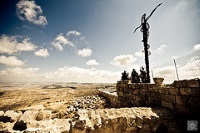
The most sacred site in Jordan, Mount Nebo is believed to be the burial site of Moses who climbed the hill in order to survey the Promised Land that he would never enter. Situated on the edge of a plateau about six miles (10km) from Madaba, Mount Nebo affords spectacular views towards Jerusalem, whose spires are visible on a clear day, and across the Jordan Valley and the Dead Sea. A modern day shrine sits on the ruins of a 6th-century Byzantine monastery, and affords protection to the original floor mosaics, while in the grounds stands the symbolic Serpentine Cross.
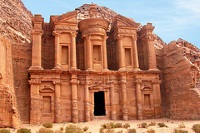
Carved into the rock and protected by rugged mountains on all sides is Jordan's most famous attraction, the ancient city of Petra, one of the world's most spectacular ruins, set within a canyon near the town of Wadi Musa.Wadi Musa, or Valley of Moses, was once the name of the valley and not just the small tourist town along the sides of the valley leading down to Petra. The town's existence is primarily to service the tourist industry as the gateway to Petra.More than 2,000 years ago, a nomadic tribe from Arabia settled in the area and these Nabateans established Petra as their capital. It became a powerful fortress city that controlled the passage of traders, and grew prosperous from the caravans crossing their land carrying spices and riches from India and Arabia.An astonishing city of monumental tombs, temples and decorative buildings carved from the solid rock was created from this wealth, which still stands as a testament to the remarkable creativity and engineering prowess of the Nabateans.Today's Petra is a staggering landscape of rock-hewn monuments, amphitheatres, palaces, arched gateways, water channels, and detailed carvings spread over a vast area. Dramatic tombs and temples unfold with each step taken further into the winding canyon.Intricate facades cut into the soaring cliff faces dwarf the ubiquitous camel drivers, traders and tourists to insignificance. Where the uppermost layers of the rock have eroded away, fantastic surreal streaks of blue, red, yellow, purple, and white cover the monuments in undulating patterns.To enter the city, visitors must first pass through a long, narrow chasm in the rock, the Siq, that winds its way for almost a mile (1.5km) with steep inclining sides that come close to meeting 656 feet (200m) above. Suddenly, the Siq opens out onto the canyon floor, dramatically revealing Petra's most famous monument: the Treasury, or Al-Khazneh.The Treasury is intricately carved into the solid rock of the pink mountain face and stands 140 feet (43m) high. The towering façade was used in the final moments of the film Indiana Jones and the Last Crusade.Petra's second most fabulous structure is the Monastery (El-Deir) situated among spectacular desert scenery high up on the mountain, and while it is bigger than the Treasury, it was never finished and is less ornate.A number of places require a bit of effort to reach, but climbing will be rewarded with enchanting views of the desert setting, an overwhelming sense of the size of the site and panoramic lookouts over the rose city of Petra, a certain highlight of any trip to Jordan.
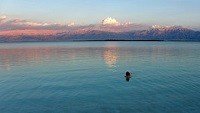
Situated about 28 miles (45km) from Amman, lies the famous attraction of the Dead Sea, the lowest point on earth at 1,335 feet (407m) below sea level. Devoid of plant or animal life due to the high salt concentration (four times saltier than normal), it is the incredible mineral rich water that has made it an internationally sought-after destination since ancient times, popular for its curative properties as well as for the experience of floating effortlessly on its surface. Most holidaymakers go to the main resort area on the northern shore at Sweimeh, where the Government Rest House provides showers, a restaurant, a beach, and the opportunity to smother oneself in the mineral-rich black mud. Accommodation is available at the Dead Sea Spa Hotel, where various medical treatments are also on offer.
Transport : Buses leave from Muhajrin station to the Government Rest House at Sweimeh.

Lying 42 miles (68km) north of Aqaba, the scenery of Wadi Rum is acclaimed as one of the most stunningly beautiful desert landscapes in the world and is a major tourist destination in Jordan. Towering mountains of weathered sandstone rise vertically from the pink desert sands where the vast emptiness and silence is takes the breath away. There are many ways to explore the vast desert interior where the likes of Lawrence of Arabia once rode. Serious mountaineers and climbers relish the challenge of its high peaks, particularly the highest in the area, Jabal Rum, and the remarkable Rock Bridge, while hikers can enjoy the grandeur of the interior by walking out into the wilderness and camping alone under the stars. Camel trips and 4x4 vehicle tours can also be arranged from the Government Rest House. Wadi Rum is home to several nomadic Bedouin families who are famous for their hospitality, and visitors are often invited to share mint tea with them inside their goat-hair tents or beside the fire under the starry sky.
Website : www.wadirum.jo
Transport : Buses are available along the Desert Highway to the turnoff, but public transport to the village of Rum is difficult so it is best to arrange a car. An infrequent bus service operates from Aqaba to the Government Rest House at Wadi.

Travel Guide powered by Word Travels, copyright © 2023 Globe Media Ltd. By its very nature information in this travel guide is subject to change at short notice and travellers are urged to verify information on which they're relying with the relevant authorities. Neither Globe Media Ltd nor Travel Vogue can accept any responsibility for any loss or inconvenience to any person as a result of information contained above.